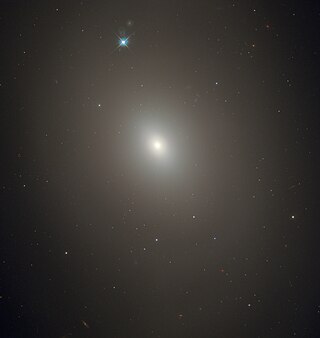Top Qs
Timeline
Chat
Perspective
Messier 85
Galaxy in the constellation Coma Berenices From Wikipedia, the free encyclopedia
Remove ads
Messier 85 (also known as M85 or NGC 4382 or PGC 40515 or ISD 0135852) is a lenticular galaxy, or elliptical galaxy for other authors,[4] in the Coma Berenices constellation. It is 60 million light-years away, and has a diameter of about 36.99 kiloparsecs (120,600 light-years) across.[1][5]
Pierre Méchain discovered M85 in 1781. It is within the outskirts of the Virgo Cluster, and is relatively isolated.[6]
Remove ads
Properties
M85 is extremely poor in neutral hydrogen[7] and has a very complex outer structure with shells and ripples that are thought to have been caused by a merger with another galaxy that took place between 4 and 7 billion years ago,[7] as well as a relatively young (<3 billion years old) stellar population on its centermost region, some of it in a ring, that may have been created by a late starburst.[8] Like other massive, early-type galaxies, it has different populations of globular clusters. Aside from the typical "red" and "blue" populations, there is also a population with intermediate colors and an even redder population.[6] It is likely transitioning from being a lenticular galaxy into an elliptical galaxy.[6]
While indirect methods imply that Messier 85 should contain a central supermassive black hole of around 100 million solar masses,[9] velocity dispersion observations imply that the galaxy may entirely lack a central massive black hole.[10]
M85 is interacting with the nearby spiral galaxy NGC 4394, and a small elliptical galaxy called MCG 3-32-38.[11]
Compared to other early-type galaxies, M85 emits a relatively smaller proportion of X-rays.[6]
Remove ads
Novae and Supernovae
Two supernovae and one luminous red nova have been observed in M85:
- SN 1960R (Type Ia, mag. 13.5), was discovered by Howard S. Gates on 20 December 1960,[12] and independently discovered by Leonida Rosino (bio-it) on 18 January 1961.[13]
- M85 OT2006-1 was discovered on the outskirts of the galaxy, by the Lick Observatory Supernova Search (LOSS) on 7 January 2006. It was classified as a luminous red nova, the first to be identified as such.[14]
- SN 2020nlb (Type Ia, mag. 17.436) was discovered by the ATLAS telescope in Hawaii on 25 June 2020.[15][16] This supernova got as bright as magnitude 12.[17]

Remove ads
See also
References
External links
Wikiwand - on
Seamless Wikipedia browsing. On steroids.
Remove ads

